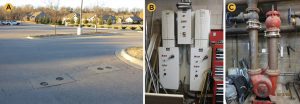Affordably Storing the Summer’s Solar Energy for Wintertime Benefit
Many may find it surprising to learn Butterfield’s 206 apartments, Commons area and Healthcare Center are all kept warm throughout much of each winter by using heat captured and stored in the ground during the summer—and inversely cooled by that same ground during the hot months of the year. Thanks to innovative, future forward-thinking by BTV’s leadership in the early 2000s, the campus now benefits from a very progressive geothermal system that is operated and maintained by the facilities team, led by Joe Perme.
Butterfield’s geothermal ground system is comprised of a series of 174 wells that reach 400 feet below the campus’ east parking lot and just east of the north covered parking area. (A)
A large pump circulates treated water through the wells and throughout the main buildings. (B) (C) Utilizing small heat pump units installed in every apartment and the large building common areas, water from the ground wells is circulated to heat or cool the room temperature and tap water in hundreds of individual areas. (D)


The geothermal coupled system is a relatively simple design, with its three processing units, the geothermal wells, a treated water circulating pump and approximately 400 small heat pumps (see drawing) Each of the individual heat pump units consists of four pieces of equipment: a room air heater/cooler, a refrigerant condenser, a vapor/liquid separator and a refrigerant letdown valve.
At the beginning of each summer, 70°F water stored in the ground wells starts a path of cooling Butterfield’s buildings, expending very little to no energy to accomplish this. Using the many small heat pumps in each apartment and common areas, warmth is pumped out of the buildings using water to carry the heat back into to the ground. Over the span of a summer, this addition of heat back into the ground gradually raises the localized ground temperature to approximately 100°F by August. As the weather cools down in the fall and winter, the water stored in that 100°F ground is then used to heat the buildings. This very efficient system requires significantly less energy than a traditional HVAC system.
Butterfield residents Dr. Roy Penney and Dr. David Renfroe, both professional engineers, have analyzed data collected daily by the campus maintenance team. Using this information to calculate the heat flow to and from the ground, they have been able to establish Butterfield’s estimated cost reduction as a result of storing summer energy for use in the winter. They have concluded the system is currently saving at least $250,000 per year, representing a savings of 80% versus the expense of heating and cooling with a traditional HVAC system. “As energy costs continue to inflate at an average of 3.5% per year, the savings will grow like money in the bank,” said Dr. Renfroe.
The success of implementing solid strategies like this system to ensure long-term cost effectiveness and campus sustainability is foremost in the minds of Butterfield’s leadership staff and residents as we look to a bright future for the Village. The contributors to this article wish to express their gratitude to past Village management for having the wisdom to invest in advanced technologies that are responsible for saving us money today.
Story contributors: Dr. David Renfroe and Dr. Roy Penney, Butterfield Residents
